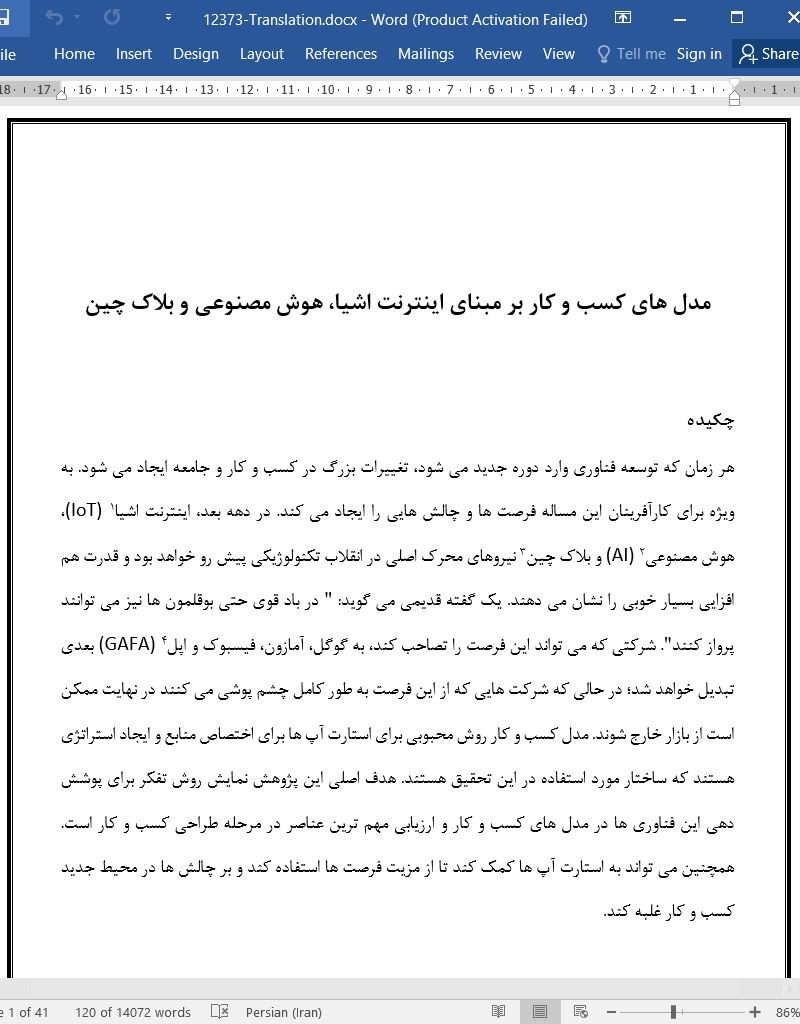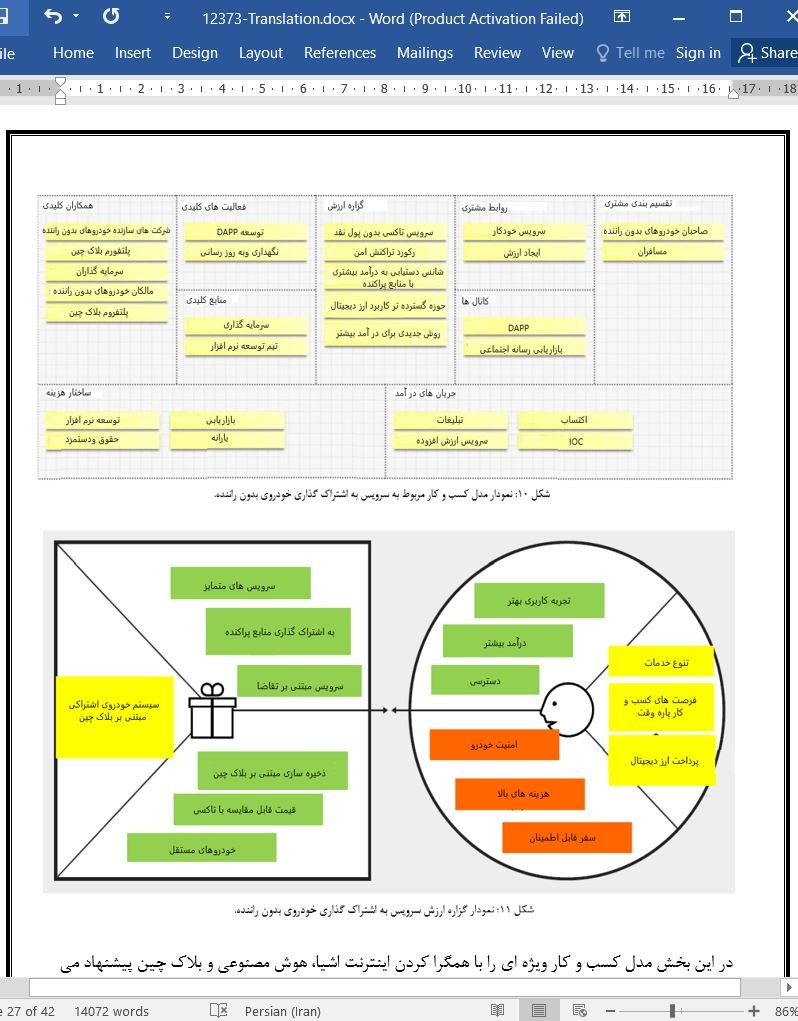
مدل های کسب و کار بر مبنای اینترنت اشیا، هوش مصنوعی و بلاک چین
چکیده
هر زمان که توسعه فناوری وارد دوره جدید می شود، تغییرات بزرگ در کسب و کار و جامعه ایجاد می شود. به ویژه برای کارآفرینان این مساله فرصت ها و چالش هایی را ایجاد می کند. در دهه بعد، اینترنت اشیا (IoT)، هوش مصنوعی (AI) و بلاک چین نیروهای محرک اصلی در انقلاب تکنولوژیکی پیش رو خواهد بود و قدرت هم افزایی بسیار خوبی را نشان می دهند. یک گفته قدیمی می گوید: " در باد قوی حتی بوقلمون ها نیز می توانند پرواز کنند". شرکتی که می تواند این فرصت را تصاحب کند، به گوگل، آمازون، فیسبوک و اپل (GAFA) بعدی تبدیل خواهد شد؛ در حالی که شرکت هایی که از این فرصت به طور کامل چشم پوشی می کنند در نهایت ممکن است از بازار خارج شوند. مدل کسب و کار روش محبوبی برای استارت آپ ها برای اختصاص منابع و ایجاد استراتژی هستند که ساختار مورد استفاده در این تحقیق هستند. هدف اصلی این پژوهش نمایش روش تفکر برای پوشش دهی این فناوری ها در مدل های کسب و کار و ارزیابی مهم ترین عناصر در مرحله طراحی کسب و کار است. همچنین می تواند به استارت آپ ها کمک کند تا از مزیت فرصت ها استفاده کند و بر چالش ها در محیط جدید کسب و کار غلبه کند.
1. مقدمه
فناوری جدید منبع مهمی برای کارآفرینان برای تولید ایده ها برای کسب و کار های خود است. انقلاب فناوری پیش رو که توسط اینترنت اشیا، هوش مصنوعی و بلاک چین هدایت می شود، به طور چشمگیری محیط اقتصادی فعلی را تغییر شکل می دهد و فرصت های بی نظیر کسب و کارهای جدیدی را ایجاد می کند. اخیراً اوین گروه از استاندارد نسل پنجم (5G) توسط تیم 3GPP منتشر شده است که تجاری سازی بزرگ اینترنت اشیا را نشان می دهد. در عین حال، هوش مصنوعی و بلاک چین به سرعت در حال تکامل هستند و توجه بسیاری از سرمایه گذاران در حوزه فناوری اطلاعات و ارتباطات (ICT) را به سوی خود جلب می کنند. هم افزایی این فناوری های جدید همانند چالش های مرتبط با آن ها عظیم است. تحت چنین شرایطی، درک این مفاهیم جدید و استفاده از آن ها برای ایجاد مدل های کسب و کار به مساله مهمی برای کارآفرینان در محیط جدید کسب و کار تبدیل شده است.
فصل 6: نتیجه گیری و کار آتی
مدل کسب و کار مبتنی بر اینترنت اشیا، هوش مصنوعی و بلاک چین به طور موفق ایجاد و تحلیل گردید. این مدل روش فکری را برای کارآفرینان به منظور به گارگیری فناوری های جدید در طراحی کسب و کارهای جدید در تحول فناورانه پیش رو فراهم می کند. با اجرای مصاحبه ها و پردازش داده های تجربی، مسائل ذیل مورد مشخص شده است:
• شناسایی سطح قدرت فناوری های جدید در تولید فرصت های کسب و کار
• بررسی تجربیات کاربر درباره نمودار مدل کسب و کار در محیط واقعی کسب و کار
• نمایش اهمیت عناصر مختف در ایجاد مدل های کسب و کار حوزه ICT
• تایید اعتبار نمودار گزاره ارزش از طریق تحلیل رگرسیون
Abstract
Every time the development of technology enters a new epoch, big changes in the business and society will follow. Especially for the entrepreneurs, it signifies both opportunities and challenges at the same time. In the next decade, IoT, AI and blockchain will be the main driving forces in the upcoming technological revolution and demonstrate great synergic potential. There is an old saying, “In a strong wind even turkeys can fly”. The company who can seize this chance may become to the next GAFAs (Google, Amazon, Facebook and Apple); whereas those who completely ignores it may be rolled out of the market eventually. Business model canvas is a very popular method for startups to align the resources and formulate the strategy, which is also the framework used in our research. The main target of this thesis is to demonstrate a thinking method to converge these new technologies in the business models and evaluate the most significant elements in the business planning stage. It could help the future startups to take advantages of the opportunities and overcome the challenges in the new business environment.
1 Introduction
New technology is an important source for entrepreneurs to generate ideas for their own business. The upcoming technological revolution led by IoT, AI and blockchain will dramatically reshape the current economic environment and create countless new business opportunities. Recently, the first batch of 5G standard has been published by 3GPP, indicating the large-scale commercialization of IoT will arrive soon. At the same time, AI and blockchain are evolving very fast, drawing many investors’ attention in the ICT industry. The synergy of these new technologies is huge, as well as the associated challenges. Under such condition, how to understand these new concepts and use them to build business models becomes a critical issue for entrepreneurs in the new business environment.
6. Conclusion and Future work
Business model based on IoT, AI and blockchain are successfully built and analyzed. It provides a thinking method for the entrepreneurs about how to utilize these new technologies in planning for new business in the upcoming technological revolution. By conducting the interviews and processing the empirical data, the following issues are pinpointed:
➢ Identify the potency level of the new technologies in generating the business opportunities.
➢ Examine user experiences of business model canvas in the real business environment.
➢ Demonstrate the significance of different elements in making the ICT business models.
➢ Verify the validity of value proposition canvas though regression analysis.
چکیده
1. مقدمه
2. پیش زمینه دانش
1-2 اینترنت اشیا
1-1-2 اینترنت اشیا و نسل پنجم
2-1-2 معماری اینترنت اشیا
2-2 هوش مصنوعی
1-2-2 یادگیری ماشین
2-2-2 مدل های یادگیری ماشین
شبکه عصبی مصنوعی و یادگیری عمیق
ماشین بردار پشتیبان (SVM)
3-2 بلاک چین و ارز رمزنگاری شده
1-3-2 قرارداد هوشمند و DApp
2-3-2 مکانیزم توافق
3. مدل های کسب و کار
1-3 نمودار مدل کسب و کار
2-3 همگرایی اینترنت اشیا، هوش مصنوعی و بلاک چین
4. روش کار
1-4 نمونه تحقیق
2-4 روش تحقیق
3-4 ساختار مصاحبه
5. تحلیل نتایج
1-5 ارزیابی فناوری های جدید
2-5 تجربیات کاربری با مدل های کسب و کار
3-5 عناصر در مدل های کسب و کار
6. نتیجه گیری و کار آتی
منابع
1 Introduction
2 Background Knowledge
2.1 Internet of Things
2.1.1 IoT and 5G
2.1.2 IoT Architecture
2.2 Artificial Intelligence
2.2.1 Machine Learning
2.2.2 Machine Learning Models
Artificial neural network and deep learning
Support Vector Machine
2.3 Blockchain and Cryptocurrency
2.3.1 Smart Contract and DApp
2.3.2 Consensus Mechanism
3 Business Models
3.1 Business Model Canvas
3.2 Convergence of IoT, AI and Blockchain
4 Methodology
4.1 Research Sample
4.2 Research Method
4.3 Interview Outline
5 Result Analysis
5.1 Evaluation of New Technologies
5.2 User Experiences with Business Models
5.3 Elements in Business Models
6. Conclusion and Future work
References
- اصل مقاله انگلیسی با فرمت ورد (word) با قابلیت ویرایش
- ترجمه فارسی مقاله با فرمت ورد (word) با قابلیت ویرایش، بدون آرم سایت ای ترجمه
- ترجمه فارسی مقاله با فرمت pdf، بدون آرم سایت ای ترجمه



